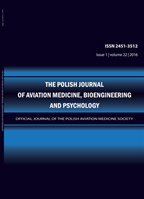2015, Volume 21, Issue 1
High Altitude Chamber Training for Military Flight Personnel – Altitude DCS Risk Assessment by Means of Echocardiographic Detection of Gas Bubbles
Andrzej JAROSZ1, Tomasz AMELJAŃCZYK1, Grzegorz KEMPA1
-------------------------------------------------------------------------------------------------
1Department of Military Aviation Education and Training, Military Institute of Aviation Medicine
Autor korenspondencyjny: Andrzej JAROSZ; Department of Military Aviation Education and Training, Military Institute of Aviation Medicine; email: andrzejjarosz[at]aim.com
Full text
Streszczenie
Introduction:
The objective of the study consisted in the assessment of the risk of decompression sickness (DCS).
Methods:
The study was conducted in 45 healthy males aged 24-45 years. A total of 64 exposures to low pressure were performed in high altitude chambers.
Results:
No clinical symptoms of DCS were observed in either patient following high altitude exposure.
Discussion:
A 30-minute inhalation of 100% oxygen appears to provide sufficient prevention against clinical symptoms of DCS in high altitude training with the ceiling of 7500 m.a.s.l.
Conclusion:
Extension of saturation periods should be considered for exposures at the ceiling of 10000 m.a.s.l.
Słowa kluczowe
decompression sicknes, hypoxia, pilots
